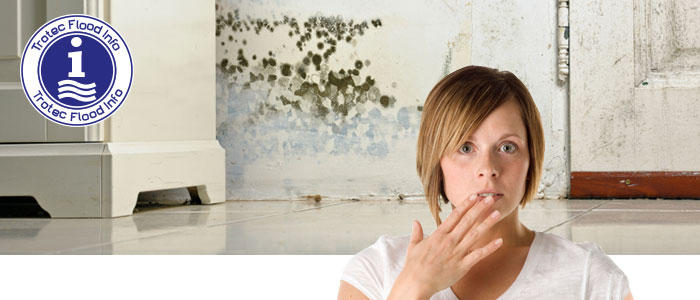
Especially in wet rooms mould growth is more common. Thus, bathrooms have to be ventilated after taking a shower or bath, in laundry cellars you should always keep a window open when drying your laundry to let the wet air get out. For the same reasons mould very often grows after water and flood damages. When only small areas are affected by mould you can remove it yourself. If the affected area is bigger you, by all means, should consult an expert because then it is not only harder to remove the mould but it can also already penetrate non-visible areas and, additionally, harm your health.
There is always a certain amount of mould spores in the air. That’s nothing to worry about because the spores don’t germ as long as the different requirements for mould growth are not given at the same time over a longer period. On the other hand mould only needs a few nutrients to grow like moisture and a certain temperature. According to the temperature many mould types are undemanding as they grow really fast between 10 °C and 40 °C.
The only thing mould usually misses to germ is moisture but through the water damage that moisture now gets into the building. A relative humidity of 70 per cent is already enough for mould to grow. You might think this is much but in Germany we get under 50 per cent only very rarely and when the outside air is wet as well ventilation is not sufficient.
Therefore, after a water damage you should use drying units as soon as possible.
What should I do when mould is already there?
The most important question is: How big is the affected area? That is necessary to know for your next steps. A recommended rule of thumb is: If the area is under a half square meter big you can remove it yourself but when it is bigger you really need an expert.
You can easily clean smooth surfaces with a usual cleaner and then rub it with 70 per cent alcohol.
Attention: Don’t smoke while doing that and ventilate well! When the surfaces are porous you can do it the same way or you vacuum the area with an “allergic vacuum” with a HEPA filter before cleaning it with alcohol. Throw away directly affected upholstery and wallpapers as fast as possible.
When the area is bigger than half a square meter the produced spores pose a high risk. With the room air the spores spread themselves in the whole room and building and can, if enough moisture is available, start to germ there, too. Thus, the affected area has to be sealed off to immediately stop a further spore distribution. Always keep the doors closed and seal them. Any further step should be made by an expert because the risk to harm yourself is too high.
Principally, it is useful to us an air cleaner when there is visible mould in a building. These units permanently filter the room air with a HEPA filter and drastically decrease the mould spore concentration. In this way you reduce the risk for you health and at the same time minimize the risk that more areas can be affected by new mould.
Additionally, when there is mould in a building by all means you should dry floor insulations only using the underpressure method with HEPA filters. Only then it is guaranteed that filtered air gets back into the room and mould spores cannot be distributed everywhere in the room or building.
Trotec Flood Info: To inform you in any case of damage
We inform you about the following topics in detail:
- Trotec assists flood victims with expertise
- How long does a dehumidification take?
- Should I rent or buy a drying unit?
- Trotec Flood Info: The right moisture measurement after flood damages
- Trotec Flood Info: When do I need an expert?
- Trotec Flood Info: What to do when mould attacks?
- Trotec Flood Info: How to dry floor insulations
- Trotec Flood Info: What to do against the smell after the flood damage?
- Trotec Flood Info: The main facts about drying units

